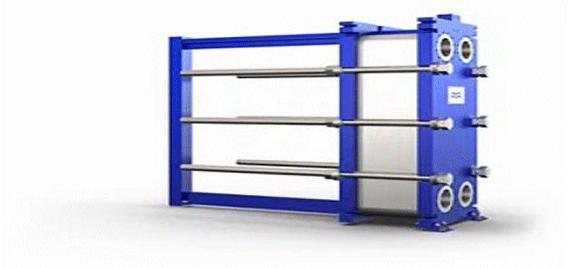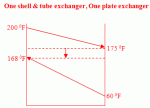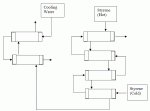Chemical and Process Engineering Resources

Implications for Size Reduction
We have seen that alternative technologies have significant size advantage over shell-and-tube heat exchangers. Now let's consider the implications of this. The first advantage is smaller plot plan for the process plant. The spacing between process equipment can be reduced. So, if the plant is to be housed in a building, the size of the building can be reduced. In any event, the amount of structural steel used to support the plant can be reduced and given the weight saving, the load on that structure is also reduced. The weight advantage extends to the design of the foundations used to support the plant.
Since, the spacing between individual equipment items is reduced, expenditure on piping is reduced. Once more we stress the savings associated with size and weight reduction can only be achieved if these advantages are recognized at the earliest stages of the plant design.
As we will briefly show, the use of alternative exchanger technologies can result in significant reduction in plant complexity. This not only enforces the savings associated with reduced size and weight (reduced plot space, structural cost savings, piping cost reduction etc.) but also has safety implications. The simpler the plant structure the easier it is for the process operator to understand the plant. The simpler the plant structure, the safer, easier and more straight forward the plant maintenance (the fewer the pipe branches that must be blanked etc.).
The alternative technologies result in reduced complexity by reducing the number of heat exchangers. This is achieved through:
- improved 'thermal contacting'
- multi-streaming.
Mechanical constraints play a significant role in the design of shell-and-tube heat exchangers. For instance, it is common to find that some users place restrictions on the length of the tubes used in such a unit. Such a restriction can have important implications for the design. In the case of exchangers requiring large surface areas the restriction drives the design towards large tube counts. If such tube counts then lead to low tube side velocity, the designer is tempted to increase the number of tube side passes in order to maintain a reasonable tube-side heat transfer coefficient.
Thermal expansion considerations can also lead the designer to opt for multiple tube passes for the cost of a floating head is generally lower than the cost of installing an expansion bellows in the exchanger shell.
The use of multiple tube passes has four detrimental effects. First, it leads to a reduction in the number of tubes that can be accommodated in a given size of shell (so it leads to increased shell diameter and cost). Second, for bundles having more than four tube passes, the pass partition lanes introduced into the bundle give rise to an increase in the quantity of shell-side fluid bypassing the tube bundle and a reduction in tube-side heat transfer coefficient. Thirdly, it gives rise to wasted tube side pressure drop in the return headers. Finally, and most significantly, the use of multiple tube passes results in the thermal contacting of the streams not being pure counter-flow. This has two effects. The first is that the Effective Mean Temperature Driving Force is reduced. The second, and more serious effect, is that a 'temperature cross' can occur.
If a 'temperature cross' occurs, the designer must split the duty between a number of individual heat exchangers arranged in series. Figures 8 and 9 below illustrate the difference between temperatures that are said to be 'crossing' and those that are not.
Many of the alternative heat exchanger technologies allow the application of pure counter-flow across all size and flow ranges. The results are better use of available temperature driving force and the use of single heat exchangers.
 |  | |
| Figure 8: No Temerature Cross | Figure 9: Deep Temperature Cross |
Let's now consider multi-streaming. The traditional shell-and-tube heat exchanger only handles one hot and one cold stream. Some heat exchanger technologies (most notably plate-fin and printed circuit exchangers) can handle many streams. It is not uncommon to find plate-fin heat exchangers transferring heat between ten individual process. Such units can be considered to contain a whole heat exchanger network within the body of a single exchanger. Distribution and recombination of process flows is undertaken inside the exchanger. The result is a major saving in piping cost.
Engineers often over-look the opportunities of using a plate and frame unit as a multi-stream unit. (Again, this will be a regular oversight if exchanger selection is not made until after the flow sheet has been developed).
A good example of multi-streaming is the use of a plate heat exchanger serving as a process interchanger on one side and a trim cooler on the other. This arrangement is particularly useful for product streams that are exiting a process and must be cooled for storage. Another popular function of multi-streaming is in lowering material costs. Often times, once streams are cooled to a certain temperature, they pose much less of a corrosion risk. Half of the exchanger can contain a higher alloy, while the other side can utilize stainless steel or a lower alloy.
In Figure 10 we show how a plate and frame unit has been applied to a problem involving three process streams. The heat transfer properties used for styrene are given in Table 3. Just one unit is used and this unit has 1,335 sq.ft. of effective surface area.
In Figure 11 we show the equivalent shell-and-tube solution. In order to avoid temperature crosses we need six individual exchangers: the cooler having two shells in series (each having 1,440 sq.ft of effective surface); the heat recovery unit having four shells in series (each having 2,116 sq.ft. of surface).
So, our plate-and-frame design involves the use of 1,335 sq.ft. of surface in a single unit. The equivalent shell-and-tube design has 11,344 sq.ft. of surface distributed across four separate exchangers.
 | ||
| Figure 10: A Multi-Stream Plate Exchanger Serving as an Interchanger and a Trim Cooler | Figure 11: Equivalent Shell and Tube Design |
| 100 °F | 150 °F | 200 °F | |
| Density (lb/ft3) | 55.5 | 53.9 | 52.3 |
| Specific Heat (Btu/lb °F) | 0.427 | 0.447 | 0.471 |
| Viscosity (cP) | 0.590 | 0.428 | 0.329 |
| Thermal Conductivity (Btu/h ft °F) | 0.077 | 0.074 | 0.070 |
| Data from PhysProps© by G.P. Engineering, Version 1.5.0 | |||

 FB
FB

5 Comments
my only query is that graphs given here ,can they be used for bloc welded plate heat exchanger designing ?.
Sir,
Very nice article and very helpful.
But my query is that how these graph comes can you
sir please provide some baics about these.
Thanks
Ashish
Hindalco
These are generalized correlations that I put together when I worked for Alfa Laval. They are appropriate for early phase design.
Dear Sir,
My NTUcold is calculated to be 0.09 based on temperature difference of 4 C (37-33)C and LMTD of 40.86C. For this NTU there does not seem to be a graph.
The cooling water temperature limits are fixed here based on cooling tower's profile.